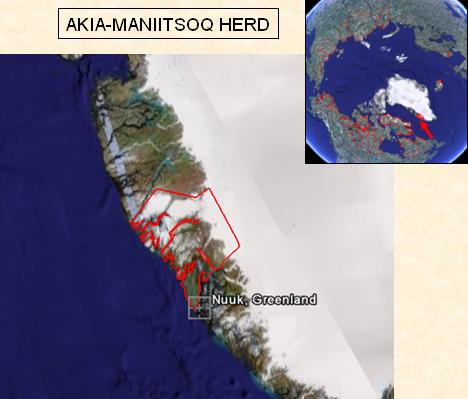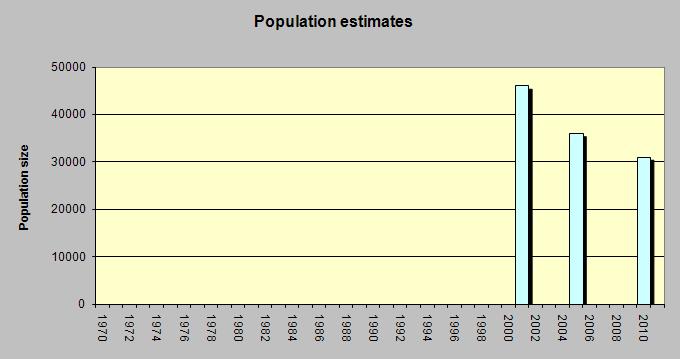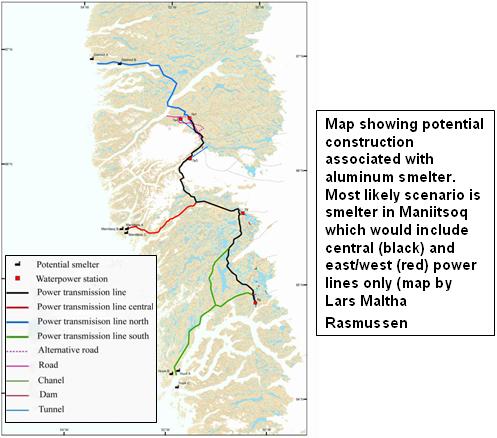Status and Trends
The Akia-Maniitsoq caribou population inhabits approximately 15,362 ice-free km2 of coastal plain, open rough upland, mountains, or alpine tundra between ca. 64-66 degrees N in West Greenland. Over the course of a year, the herd appears to utilize much of this range. The northern border of their range is marked by the long Kangerlussuaq fjord in combination with the relatively small ice cap, Sukkertoppen, which has also been described as a large glacial tongue of the Greenland Ice Cap. The southern boundary is formed by Godthåbsfjord, which cuts all the way from the seacoast to the great inland Greenland Ice Cap. The western boundary is the Davis Strait seacoast, while the eastern border is the expanse of the Greenland Ice Cap. The largest human settlement is Maniitsoq, a seacoast city of about 5,000, while some hundreds more live scattered along the seacoast in 3 or 4 smaller settlements. However, Greenland''s capital, Nuuk, with a population of ca. 15,000, is nearby on the south side of Godthåbsfjord. Large predators (e.g., wolves, bears, lynx, wolverine) are nonexistent in West Greenland. Currently roads are limited to the settlements, do not link settlements, and do not penetrate the terrain.
Caribou have been native to Akia-Maniitsoq for several millennia. Today, the Akia-Maniitsoq caribou population is composed of native west Greenland caribou (Rangifer tarandus groenlandicus) genetically mixed to some extent with feral semi-domestic reindeer (Rangifer tarandus tarandus), which were introduced to the Godthåbfjord / Kapisillit area in 1952. The native cows are typically polled, and antlered females are uncommon. The population is not a cohesive aggregated "herd", but moves about in small groups generally averaging 3-4 caribou. There exists a minimum of synchrony in the timing of migration from winter range to the calving grounds. Annual mass migrations, in which thousands of animals move along together, as observed in North America, does not occur. However separated in time, animals all tend to use the same routes, which are generally in a northeast-southwest direction. Total distance travelled by Akia-Maniitsoq caribou in their annual migrations might not exceed 150 km. Many will move far less and some animals do not migrate at all, but remain within a small radius, e.g., 10 km, their entire lives.

Follow satellite collared reindeer by going to http://en.nunagis.gl and clicking on "Reindeer with GPS" and highlighting individual reindeer or all collared cows.
Caribou calving grounds for any herds in Greenland are assumed to be located in close proximity to the Greenland Ice Cap, or at mountainous locations above 300 metres elevation. Few are identified. There are no current calving ground surveys estimating early calf survival or birth weights. An aerial helicopter survey to delineate the extent and location of calving areas is planned for June 2009.
Although archaeological records show that caribou have been hunted, specifically in the inland areas, for over 3,500 years. Historical journals and harvest records since 1721 suggest that at least 2 abrupt population cycles have occurred. After many decades of scarcity herds appear to increase exponentially, peak, and then seemingly disappear suddenly and remain scarce for the better part of a century before again recovering. Local knowledge and recent harvests suggest that the population has been increasing since the 1960''s, has likely been high for several decades, and may already have peaked. Monitoring since 2001 supports this. If the historical cycle repeats itself, then the expected future trend for the Akia-Maniitsoq population will be a decline to scarcity. A decrease in numbers was observed between 2001 and 2005.
Along with several other herds in West Greenland, the Akia-Maniitsoq caribou population was aerially surveyed annually for late winter abundance from 1990 to 1996. However, the results were gross underestimates. This led to the erroneous conclusion that there were too few caribou in West Greenland and hunting was restricted. New helicopter transects surveys for late winter (March) abundance and herd structure were done in 2001 and 2005.
The 2001 estimate of about 46,236 caribou (37,115 - 55,808; 80% CI) was almost a 7-fold increase from the earlier surveys. Four years later, using precisely the same survey design and observers, a decline in herd number was observed. The March 2005 pre-calving population estimate for the Akia-Maniitsoq herd was about 35,807 caribou (27,474 - 44,720; 90% CI). Caribou density was 3.0 caribou per km2 in the high-density stratum, and 1.1 per km2 in the low-density stratum. Mean group size was 4.33 ± 2.91 S.D. The March 2005 calf ("short-yearlings" i.e., 10 month old calves) percentage was 14%, and the annual late winter recruitment of "short-yearling" calves was 24 calves per 100 cows. The bull to cow ratio was 0.45. In March 2010 the population estimate for this herd was 31,000 (27,500 - 44,700; 90% CI) with density in prime habitat about 2 caribou per sq km.

Management
The Greenland Home Rule government is responsible for caribou management, specifically the Styrelsen for Fiskeri, Fangst og Landbrug (Department of Fish, Game and Agriculture) and under that the Styrelsen for Fangst (Division for Hunting). Upon request by this department or division, recommendations based on scientific data are provided by the Greenland Institute for Natural Resources, which is an applied science research institute whose mandate is sustainable use of Greenland''s natural resources.
The Fangstrådet (Greenland Hunting Counsel / Board), designated under parliamentary law, also makes recommendations to the Greenland Cabinet on issues concerning fishing, hunting, management or natural resources. The Fangstrådet meets regularly and the board chairperson can make public statements on behalf of the board. Board representatives come from the entire country and include both commercial and sport hunter organizations, businesses linked to natural resource use, the municipal governments, Greenlandic nature groups and federal government agencies. The board aims to optimize the economic, social and cultural benefits of hunting and fishing in keeping with a sustainable use of the natural resources.
Although given historical cycles a declining trend in caribou abundance may be expected to begin in the foreseeable future, present numbers remain high so harvests are open (no bag limit) and seasons long. The continued high densities of caribou on this range now and for at least the past decade have managers concerned about overgrazing and trampling. To halt further herd growth and perhaps reduce herd size, beginning in 2001 quotas increased dramatically and seasons lengthened. Since 2003 there have been open harvests and the autumn hunting season has typically been 3½ months long. Further hunting continues through the rut to encourage the removal of cows, and increase the percentage of females in the harvest. Hunters prefer bulls, but these are considered unpalatable during the rut. A winter hunt is permitted for commercial hunters. The harvest strategy is an attempt to reduce density to a target of about 1.2 caribou per km2, which might be compatible with sustainable range use. All hunters must report the age class (calf, juvenile, adult), sex, location of kill ("X" on a map), rump fat depth, and if the animal was a cow, whether she had a calf-at-heel.
Harvest regulations for 2008 / 2009
• Open harvest - There is no quota for commercial or sport hunting
• A limited number of licences (about 400) are allocated for trophy hunting.
• Commercial hunting season is from 1 August 2008 until 28 February 2009.
• Sport hunting season is from 1 August until 15 November 2008.
• Trophy hunting season is from 1 August until 15 October 2008, and from 11 March until 11 April 2009.
There are no areas of restricted hunting in the range of this herd. As in the past, at present there are no management plans or management agreements on the Akia- Maniitsoq caribou population.
Threats
Ecosystem change: The major potential threat to caribou use and distribution in the region is the proposed construction of an aluminium smelter on the coast of West Greenland (possibly close to the city of Maniitsoq), several hydro power plants near the Ice Cap and associated hydro power transmission lines between the two. The transmission lines would transect all caribou migration routes between the calving grounds near the Ice Cap and wintering grounds to the west. The Danish National Environmental Research Institute and the Greenland Insitute of Natural Resources have compiled a strategic environmental assessment. Construction is proposed to begin in 2010 and production by 2014.

The next potential threat to the Akia-Maniitsoq herd is the construction of an iron ore mine near the Ice Cap in what is suspected to be sensitive calving ground habitat. This mine would require construction of a harbour on the north shore of Godhåbsfjord, and a road and pipeline running to the mine from the harbour. The road and the pipeline would run through known summer and winter caribou range. A proposed bridge would be built at an important caribou river crossing, traditionally used by the caribou during migrations between wintering and calving grounds. The impacts on caribou range use caused by construction and subsequent human disturbance are unknown. Certainly hunters would have easier access to the herd year round. Also, non-consumptive human use of the area would probably increase significantly. Portions of the herd''s range may be lost. Construction has not yet begun.
Accelerated climate change: Unpredictable winters that may have extended periods with no snow covering the ground or icing events have occurred since 2000. The earlier arrival of spring has been noted. Direct affects on the herd have not been studied.
Reports
KEY REPORTS
Born E.W., Heide-Jørgensen M.P., Merkel F., Cuyler C., Barne-Neve P. & Rosing-Asvid A. 1998. Grønlandske fugle, havpattedyr og landpattedyr. Greenland Institute of Natural Resources. Technical report No. 16. 70 pp. (In Danish)
Cuyler C. 2007. West Greenland caribou explosion: What happened? What about the future? Proceedings of the 11th North American Caribou Workshop, Jasper, Alberta, Canada, 23-27 April 2006. Rangifer, Special Issue No. 17: 219-226.
Cuyler L.C. & Østergaard J. 2005. Fertility in two West Greenland caribou populations 1996/97: Potential for rapid growth. Wildlife Biology. 11(3): 31-37.
Cuyler C. 1999. Vildren (Rangifer tarandus groenlandicus) -In: Bugge-Jensen, D. (ed.) Kapitel 4.5. Grønlands Biodiversitet - et Landstudie. Greenland Institute of Natural Resources. Technical report No. 27. 220 pp. (In Danish with English summary)
Cuyler C. & Linnell J.D.C. 2004. Årlig vandringsmønster hos satellitmærkede rensdyr I Vestgrønland. Kapitel 6.: 189-210 - In: Aastrup P. (ed.) Samspillet mellem rensdyr, vegetation og menneskelige aktiviteter i Vestgrønland Greenland Institute of Natural Resources. Technical report No. 49. 321 pp.
Cuyler L.C., Rosing M., Egede J., Heinrich R. & Mølgaard H. 2005. Status of two west Greenland caribou populations 2005; 1) Akia-Maniitsoq & 2) Kangerlussuaq-Sisimiut. Greenland Institute of Natural Resources. Technical report No. 61. Part I-II, 64+44 pp.
Cuyler L.C., Rosing M., Linnell J.D.C., Lund P.M., Jordhøy P., Loison A. & Landa A. 2003. Status of 3 West Greenland caribou populations; 1) Akia-Maniitsoq, 2) Ameralik & 3) Qeqertarsuatsiaat. Greenland Institute of Natural Resources. Technical report No. 46. 74 pp.
Linnell J.D.C., Cuyler C., Loison A., Møller-Lund P., Motzfeldt K.G., Ingerslev T. & Landa A. 2000. Scientific basis for managing the sustainable harvest of caribou and muskoxen in Greenland for the 21st century: an evaluation and agenda. Greenland Institute of Natural Resources. Technical report No. 34. 55 pp.
Loison A., Cuyler C., Linnell J.D.C. & Landa A. 2000. The caribou harvest in west Greenland, 1995-1998: Sex, age and condition of animals based on hunter reports. Greenland Institute of Natural Resources. Technical report No. 28. 33 pp.
Loison A., Cuyler L.C., Linnell J.D.C. & Landa A. 2001. Sex, age, condition and tooth wear of harvested caribou Rangifer tarandus groenlandicus in west Greenland, 1995-1998. Wildlife Biology 7(4): 263-273.
Tamstorf, M.P., Aastrup, P. & Cuyler, L.C. 2005. Modelling critical caribou summer ranges in West Greenland based on ARGOS and Landsat data. Polar Biology. 28: 714-724, DOI: 10.1007/s00300-005-0731-8.
KEY LINKS:
http://dk.nanoq.gl/
The Greenland Home Rule government website. Access to the Department of Fisheries, Hunting and Agriculture is only possible in Danish and Greenlandic. The English version of the government website lacks access.
http://www.natur.gl
The Greenland Institute for Natural Resources website. This website is currently (January 2009) under re-construction. Similar to the Greenland government''s website, full access is only possible in Danish and Greenlandic. An English version is expected in the future.
http://dk.nanoq.gl/Emner/Erhverv/Erhvervsomraader/Fangst_og_Jagt/Fangstraadet
The Fangstrådet (Hunting Council / Board)
Contacts
Christine Cuyler, Ph.D.
Research Scientist
Greenland Institute of Natural Resources
Kivioq 2
P.O. Box 570
DK - 3900 Nuuk
GREENLAND
Telephone: (+299) 36 12 00
Direct Telephone: (+299) 36 12 40
Fax: (+299) 36 12 12
E-mail: chris.cuyler''at''natur.gl
website: www.natur.gl
Josephine Nymand, Ph.D.
Research Scientist
Greenland Institute of Natural Resources
Kivioq 2
P.O. Box 570
DK - 3900 Nuuk
GREENLAND
Telephone: (+299) 36 12 00
Fax: (+299) 36 12 12
E-mail: jony''at''natur.gl
website: www.natur.gl
Fernando Ugarte
Head of Department of Mammals & Birds
Greenland Institute of Natural Resources
Kivioq 2
P.O. Box 570
DK - 3900 Nuuk
GREENLAND
Tel: (+299) 36 12 00
Direct Tel: (+299) 36 12 42
Fax: (+299) 36 12 12
E-mail: feug''at''natur.gl
website: www.natur.gl
Styrelsen for Fiskeri, Fangst og Landbrug
Department for Fishing, Hunting and Agriculture
Post Box 680
3900 Nuuk
Telephone: + 299 34 50 00
Fax: + 299 32 52 87
E-mail: apna''at''gh.gl
